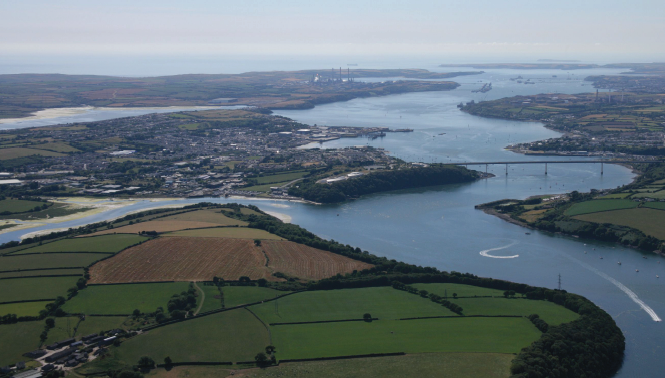News
Pembrokeshire farmers’ fears over WG scheme


River Cleddau: 2,000 farms affected
WELSH GOVERNMENT plans to introduce restrictions on the activities that farmers can carry out on their land and designated times of the year has been met with scepticism and concern by Pembrokeshire’s farmers.
The Welsh Government has introduced a consultation on its scheme to designate the Haven Waterway and two Cleddaus as a Nitrate Vulnerable Zone (NVZ). Farmers claim that the move will increase the costs of production, threaten farms’ viability, and have an adverse effect on the Pembrokeshire Early crop.
WHAT IS AN NVZ?
An NVZ designation places a series of restrictions on farmers’ ability to use certain types of fertiliser on their land at prescribed times of the year. The aim is to reduce the effect that run off from agricultural land has on the environment.
The effects of nitrate pollution on the aquatic environment can be significant. High nitrate concentrations can cause a deterioration in water quality and disturb the ecosystems of rivers and other watercourses. Over enrichment of water can lead to a depletion of oxygen levels leading to a loss of marine life and causes increased toxic and non-toxic algal blooms, which make the situation worse by reducing water transparency. Nitrate pollution can reduce not only the diversity of plant life but also damage fish and shellfish stocks, as the algae consume the available oxygen suffocating other life.
In the worst case scenario, anaerobic (oxygen-starved) conditions cause toxic bacteria to thrive and can create ‘dead zones’.
In order to tackle the threat posed by nitrate pollution, in 1991 the European Union adopted rules governing nitrate pollution and sought to regulate the extent of nitrate pollution entering the environment.
UKIP OPPOSES MOVE
Speaking to The Herald in August, UKIP Wales leader Neil Hamilton told us: “With the imminence of Brexit, it is absurd for the Welsh Government to go ahead with consultations on potential NVZs under the EU Nitrates Directive.
“If implemented, these new zones will adversely affect about 25% of the Welsh dairy herd and 50% of the Welsh potato crop. I will oppose strongly any move by the Welsh Government to impose these zones.
“Farmers don’t need to be dictated to. They know what is best for their land and their crops and they should be allowed to make their own decisions based on personal knowledge of their land and weather conditions.”
Notwithstanding Mr Hamilton’s words, the Welsh Government has decided that now is the time – with Article 50, triggering the UK’s departure/divorce from the EU, due to be activated next March at the latest – to embark upon a round of consultations about the imposition of a regulatory burden based on EU law upon farmers already uncertain about the effect of Brexit upon their incomes.
The rationale underpinning the consultation is based on the environmental principles underpinning the original policy. However, the potential impact of agriculture around the Haven Waterway is significant.
‘EXTREMELY COSTLY’
Pembrokeshire NFU Cymru County Chairman, Walter Simon, said: “Up to 2,000 farmers in in the western and eastern Cleddau river catchments and the Milford Haven estuary could face strict limitations on the use of nitrates on their farms and also face the challenge of a whole host of tough new rules due to potential plans from Welsh Government to extend Nitrate Vulnerable Zones (NVZ) in Wales.
“The Welsh Government are now consulting on proposals that have the potential to bring in 25% of all the land in Wales which is used for milk production and also half of the area that is used to grow potatoes in Wales under a new NVZ designation.”
Mr Simon explained his members’ concerns: “The potential new rules include strict limitations and restrictions on the amount of livestock manure, slurry and fertiliser farmers can spread on their land, particularly during the autumn and winter months and, in tandem with this, there would be very strict requirements on farmers to keep detailed records.
“Dairy and beef farmers would also be required to have storage facilities for slurry and manure for five months from October to March. This is likely to be extremely costly for farmers to implement at a time when they’re receiving very low prices in the market for their products.”
He concluded by questioning the basis upon which the Welsh Government was advancing the plans at this time: “In the context of the EU Referendum decision, it’s very questionable if the implementation of this EU directive should be taken forward. However, if Welsh Government choose to implement this then NFU Cymru is calling on them to base any new NVZ areas on sound scientific evidence. We will scrutinise the evidence in great detail and we’re willing to challenge government plans unless they are robust and stand up to scrutiny.”
‘LONG TERM DAMAGE’ CLAIM
Responding for the Welsh Conservatives, Paul Davies AM warned that excessive regulations could do ‘long term damage’ to the farming industry.
The Conservatives’ Rural Affairs spokesperson said: “Farmers across Wales will be rightly concerned about the Welsh Government’s proposed new Nitrate Vulnerable Zones (NVZ) designations.
“The regulatory burden will do nothing to attract people to farming and the costs attached to these proposals will put a heavy burden on Welsh farmers, at a time when the Welsh Government should be doing more to support our rural economy.
“It seems that both options would unnecessarily and unreasonably affect Welsh farmers.
“That’s why it’s important that a strong message is sent to the Welsh Government and I strongly urge farmers from all parts of the country to respond to this consultation and make sure their voices are heard.”
WG APPROACH LACKS EVIDENCE
FUW Senior Policy Officer Dr Hazel Wright, who has been representing the Union in the review process, said: ‘‘The FUW has been involved in the NVZ review and has made successful representations on several designations, which resulted in their removal from the discrete areas option of the consultation.
“However, the number of proposed new designations remain a concern and the FUW continues to reiterate the operational and financial impacts those designations would have upon farms that reside within an NVZ area. Given such costs, there must be full justification for any proposed increases in designation.”
Two options outlined in the consultation include the continuation of the discrete approach to designation or the designation of the whole of Wales as a NVZ. A continuation of the discrete approach would see an increase in the amount of NVZ designations in Wales rise from 2.4% to 8%. This would mean significant changes to NVZ designation in counties such as Pembrokeshire, Carmarthenshire and Anglesey.
“The FUW remains resolutely against the option to apply the action programme throughout the whole of Wales as this would require all landowners to comply with the NVZ action programme measures.
“There is a distinct lack of evidence for a whole territory approach and the difficulties and costs associated with regulatory compliance for farms whose land does not drain into nitrate polluted waters, makes this option both unwarranted and unreasonably excessive,” added Dr Wright.
2,000 FARMS COULD BE AFFECTED
Mid and West AM, Shadow Cabinet Secretary for Energy, Climate Change and Rural Affairs, Simon Thomas said: “Plaid Cymru understands that up to potentially 2,000 farms that border on the Cleddau tributaries and the Cleddau estuary area would be affected. These farmers would face the need to make huge investments at a difficult time, for example, in slurry storage.
“We have called upon the Welsh Government to provide those farmers with support to meet the requirements without jeopardising their businesses.
“Natural Resources Wales would be tasked with regulating the NVZs. The organisation has faced cuts in the last Assembly Term. We have called upon the Welsh Government to ensure that NRW has the resources it needs to carry out its duties. As much as possible, both NRW and the Labour Welsh Government should work to achieve the aims of the NVZ through voluntary means and must also examine other potential factors outside of farming.”
NFU Cymru is encouraging affected farmers within the county to get involved with the consultation process. A meeting will be held on Thursday (Oct 13) at The Pavilion, Pembrokeshire Showground, Withybush, Haverfordwest, starting at 7:30pm. Access to The Pavilion for the meeting is via Gate 3, which is 200m past the main entrance to the Showground.
Crime
Man accused of Milford Haven burglary and GBH remanded to Crown Court

A MILFORD HAVEN man has appeared in court charged with burglary and inflicting grievous bodily harm, following an incident at a flat in the town earlier this week.
Charged after alleged attack inside Victoria Road flat
Stephen Collier, aged thirty-eight, of Vaynor Road, Milford Haven, appeared before Llanelli Magistrates’ Court today (Friday, Dec 5). Collier is accused of entering a property known as Nos Da Flat, 2 Victoria Road, on December 3 and, while inside, inflicting grievous bodily harm on a man named John Hilton.
The court was told the alleged burglary and assault was carried out jointly with another man, Denis Chmelevski.
The charge is brought under section 9(1)(b) of the Theft Act 1968, which covers burglary where violence is inflicted on a person inside the property.
No plea entered
Collier, represented by defence solicitor Chris White, did not enter a plea during the hearing. Prosecutor Simone Walsh applied for the defendant to be remanded in custody, citing the serious nature of the offence, the risk of further offending, and concerns that he could interfere with witnesses.
Magistrates Mr I Howells, Mr V Brickley and Mrs H Meade agreed, refusing bail and ordering that Collier be kept in custody before trial.
Case sent to Swansea Crown Court
The case was sent to Swansea Crown Court under Section 51 of the Crime and Disorder Act 1998. Collier will next appear on January 5, 2026 at 9:00am for a Plea and Trial Preparation Hearing.
A custody time limit has been set for June 5, 2026.
Chmelevski is expected to face proceedings separately.
News
Woman dies after collision in Tumble as police renew appeal for witnesses

POLICE are appealing for information after a woman died following a collision in Tumble on Tuesday (Dec 2).
Officers were called to Heol y Neuadd at around 5:35pm after a collision involving a maroon Skoda and a pedestrian. The female pedestrian was taken to hospital but sadly died from her injuries.
Dyfed-Powys Police has launched a renewed appeal for witnesses, including anyone who may have dash-cam, CCTV footage, or any information that could help the investigation.
Investigators are urging anyone who was in the area at the time or who may have captured the vehicle or the pedestrian on camera shortly before the collision to get in touch. (Phone: 101 Quote reference: DP-20251202-259.)
News
Greyhound Bill faces fresh scrutiny as second committee raises “serious concerns”

THE PROHIBITION of Greyhound Racing (Wales) Bill has been heavily criticised for a second time in 24 hours after the Senedd’s Legislation, Justice and Constitution (LJC) Committee published a highly critical Stage 1 report yesterday.
The cross-party committee said the Welsh Government’s handling of the legislation had “in several respects, fallen short of the standard of good legislative practice that we would normally expect”.
Key concerns highlighted by the LJC Committee include:
- Introducing the Bill before all relevant impact assessments (including a full Regulatory Impact Assessment and Children’s Rights Impact Assessment) had been completed – a step it described as “poor legislative practice, particularly … where the Bill may impact on human rights”.
- Failure to publish a statement confirming the Bill’s compatibility with the European Convention on Human Rights (ECHR). The committee has recommended that Rural Affairs Minister Huw Irranca-Davies issue such a statement before the Stage 1 vote on 16 December.
- Inadequate public consultation, with the 2023 animal-licensing consultation deemed “not an appropriate substitute” for targeted engagement on the specific proposal to ban the sport.
The report follows Tuesday’s equally critical findings from the Culture, Communications, Welsh Language, Sport and International Relations Committee, which questioned the robustness of the evidence base and the accelerated legislative timetable.
Industry reaction Mark Bird, chief executive of the Greyhound Board of Great Britain (GBGB), described the two reports as leaving the Bill “in tatters”.
“Two consecutive cross-party Senedd committees have now condemned the Welsh Government’s failures in due diligence, consultation and human rights considerations and evidence gathering,” he said. “The case for a ban has been comprehensively undermined. The responsible path forward is stronger regulation of the single remaining track at Ystrad Mynach, not prohibition.”
Response from supporters of the Bill Luke Fletcher MS (Labour, South Wales West), who introduced the Member-proposed Bill, said he welcomed thorough scrutiny and remained confident the legislation could be improved at later stages.
“I have always said this Bill is about ending an outdated practice that causes unnecessary suffering to thousands of greyhounds every year,” Mr Fletcher said. “The committees have raised legitimate procedural points, and I look forward to working with the Welsh Government and colleagues across the Senedd to address those concerns while keeping the core aim of the Bill intact.”
A Welsh Government spokesperson said: “The Minister has noted the committees’ reports and will respond formally in due course. The government supports the principle of the Bill and believes a ban on greyhound racing is justified on animal welfare grounds. Work is ongoing to finalise the outstanding impact assessments and to ensure full compatibility with the ECHR.”
The Bill is scheduled for a Stage 1 debate and vote in plenary on Tuesday 16 December. Even if it passes that hurdle, it would still require significant amendment at Stages 2 and 3 to satisfy the committees’ recommendations.
-

 Crime3 days ago
Crime3 days agoDefendant denies using Sudocrem-covered finger to assault two-month-old baby
-

 Crime2 days ago
Crime2 days agoPembroke rape investigation dropped – one suspect now facing deportation
-

 News2 days ago
News2 days agoBaby C trial: Mother breaks down in tears in the witness box
-

 Crime7 days ago
Crime7 days agoMan denies causing baby’s injuries as police interviews read to jury
-

 Crime3 days ago
Crime3 days agoLifeboat crew member forced to stand down after being assaulted at Milford pub
-

 Crime3 days ago
Crime3 days agoDefendant denies causing injuries to two-month-old baby
-

 Crime3 days ago
Crime3 days agoPembrokeshire haven master admits endangering life after speedboat collision
-

 Crime1 day ago
Crime1 day agoMother admits “terrible idea” to let new partner change her baby’s nappies alone


















